Podcast Episode 641: The Best of the FHB Podcast, Volume 7
From fold-up windows to painting brick, a selection of our favorite clips from episodes 181-185.
Follow the Fine Homebuilding Podcast on your favorite app. Subscribe now and don’t miss an episode.
 |
Note: The Fine Homebuilding Podcast team is always looking for ways to improve, so we’re switching up our video strategy. But don’t worry—you’ll still be able to watch all your favorite clips from the show. Check out our YouTube channel or keep scrolling to see more!
Corey asks about windows that connect kitchens and decks. Mark wonders about pin foundations. Brent offers advice for keeping kitchen costs down and how to be a remodeler without a truck. Aaron shares a list of what to look for when considering a house purchase. Allen inspires a conversation about painting brick.
Connecting indoor and outdoor countertops with windows
In FHB Podcast 181, Corey from Roanoke, Va. writes:
Hello FHB team. I have loved your podcasts and truly believe you bring all kinds of helpful things to the table.
My wife and I are about to start on a kitchen remodel for a house we moved into six months ago. We’ve worked with a GC and a designer to ensure our kitchen is truly a functional space because we both like to cook, as do our kids. We’re doing the full nine yards: moving some walls to optimize the space, relocating the sink and island, new cabinets and appliances.
I’d like your input on the following:
We have a triple bank of windows that we found were racked during the home inspection, so they’re being replaced during this renovation. During this project we plan to add a screened porch with bar-type seating on the inside and outside of this window, so when the windows are open there is a pass-through to the porch.
Casement windows will cause issues when swung out, so I’m looking for your opinions on either an accordion-type window that folds onto itself when open, or a window that looks like a traditional double-hung but swings up like the FoldUp window. It appears that the FoldUp version can be quite wide and can fold either in or out. Obviously we’re looking for a window that’s strong over time, easy to open/close, and energy efficient.
We would love to hear your thoughts or maybe you have other options we should consider.
Thanks FHB team!
RELATED STORIES
- Cantilevered Connection
- Kitchen Remodel with Sliding Pass-Through Window
- ProTek Pocket Windows
- NanaWall Folding Windows
Pros and cons of pin foundations
In FHB Podcast 182, Mark from Cincinnati, Ohio, writes:
Hello guys.
Your podcast is the best! I never miss it. In podcast 175, you discussed helical foundations versus concrete. You did not mention pin foundations, which have been in use for many years in the upper Midwest, particularly in Minnesota, Wisconsin, and Michigan. They appear to be affordable, fast, and require little digging. Most important, they are supposedly more resistant to frost heave. I plan to use them on a deck I’m going to rebuild later this year. Could you address the pros and cons of these? Thanks!
RELATED STORIES
- Precast Piers and Other Footing Options
- VIDEO: Deck Footing Options
- It’s Time to Consider Helical Pile Footings
Tips for keeping kitchen remodels affordable
In FHB Podcast 185, Brent from Canada writes:
Hi FHB team,
First off thanks for the great content on the podcast and in the magazine. I have learned so much from listening and reading. I thought I would drop you a quick note about two of the items you talked about in podcast 180.
On keeping the costs down in a kitchen remodel, I have a bit of experience with this as I have hacked my way through two apartment kitchen remodels (attached photos). I only have before pictures for the second one, the first one was so bad when we moved in the dishwasher caught on fire when the inspector turned it on. They both cost around $15K in Canadian paseos, so about $450 converted to USD. I am an engineer by trade, so I really over-analyzed the costs, and I think I learned some takeaways to save money on kitchen renovations:
1) Plan, plan, plan: It sounds geeky, but without keeping track of the costs of your different options with a spreadsheet or something you will never know where you are spending or could save money. Scrutinize the big ticket items first and work through to the less expensive things.
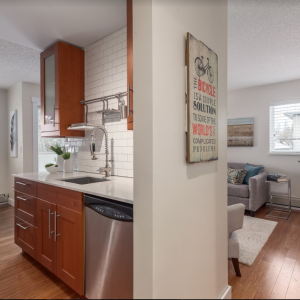 |
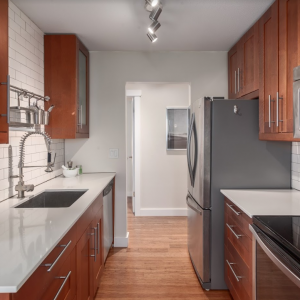 |
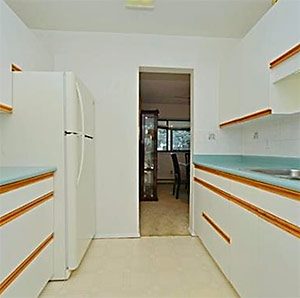 |
2) Plan for standard-sized appliances: You wont be able to find as many deals if you spec’d a 27-in. refrigerator.
3) Stick with a range: Going for a slide-in range with a downdraft vent or a separate cooktop and wall oven will add thousands.
4) Keep things out of the island: Resist the temptation to put the sink or range in the island because the ventilation, electrical, and plumbing costs will explode. Put the island on wheels if the electrical inspector tells you to put an outlet in it ?
 |
 |
 |
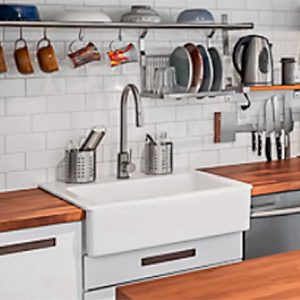 |
5) Countertops: If you like wood, go for it. You could replace the wood countertops in my second renovation eight times before you hit the cost of the quartz ones in the first renovation. The wood holds up pretty well, and it gets character over time.
6) Sink: If you can find a cheaper farmhouse sink that goes the full depth of the counter like the one in the photo above, you can save a few hundred dollars on countertops, and the install is super easy.
7) Cabinets: If you are going budget, you can’t beat IKEA. The next cheapest option is at least 50% more. The IKEA hardware is great, and the carcases are fine and have a warranty. If you want to go bougie, you could order custom fronts for them. Also, keep the number of drawers to a minimum and consider open shelving.
8) Finishes: Pay attention to the costs of tile. You probably won’t use much, but high-end tile can cost as much as 10x as low-end tile. You can make the cheaper stuff look good if you are creative.
9) Contractors: Have a very detailed plan ready for contractors before they arrive, hang around when they are doing the work, and have them charge you time and materials. We planned the routes for wires and plumbing, marked out exact locations for fixtures, opened up walls ahead of time, had the key to the electrical room, all the fixtures were on site, etc. If you are paying $100+ per hour, you want the person to be spending the time doing what they are trained for, not discussing if you want an outlet at 18 in. or 24 in.
10) Do as much work as you can on your own: Duh.
About work trucks:

While I am not a pro doing this work all day, I do agree that most contractors and even DIYers are way “over trucked.” I agree wholeheartedly with Matt that people have to take responsibility and be more aware of their actual needs and the over-consumption associated with driving a truck just because or taking 15 extra trips to Home Depot because of poor planning. We could have easily “justified” buying a truck doing three major renos in five years, but we stuck with our trusty Honda Civic and made it work. A game changer for us was the car-sharing service Modo, which has trucks and cargo vans parked around big cities for reasonable prices and it’s way more convenient than renting. Every time I go to Home Depot there are at least three or four full-sized trucks picking up one or two pieces of lumber that I could fit in a Honda Civic with no problem (see attached photo).
(Honda Civic has an 850-lb. payload capacity.)
RELATED STORIES
Options for painting brick
In FHB Podcast 184, Ben writes:
In podcast episode 183, Allen from Western Kentucky wrote in about painting brick. He mentioned a product made by Romabio, which is mineral-based, but he was concerned it would be tough to find somebody locally who is familiar with the product.
Travis Allen, an estimator with Hansell Painting, explained there are several ways to color brick.
RELATED STORIES
Making sure you’re buying a good house
In FHB Podcast 185, Aaron from Pittsburgh writes:
Greetings podcast team,
I’m a huge fan of the show. Keep up the good work.
I recently got together with some friends from Washington, D.C., and the real estate market there is crazy. Many houses are on the market for less than a week. If you want to buy, you often have to come pre-approved for a mortgage, offer over the asking price, and forego having your own inspection. Most houses have pre-purchase inspections done, so you get to see the report but not necessarily hire your own inspector.
My question: With such short evaluation windows, what advice would you give people that are buying their first house in this market? To ask another way, are there red flags or obvious things to look for that can hint at the build quality of a house?
Best Regards from The Steel City
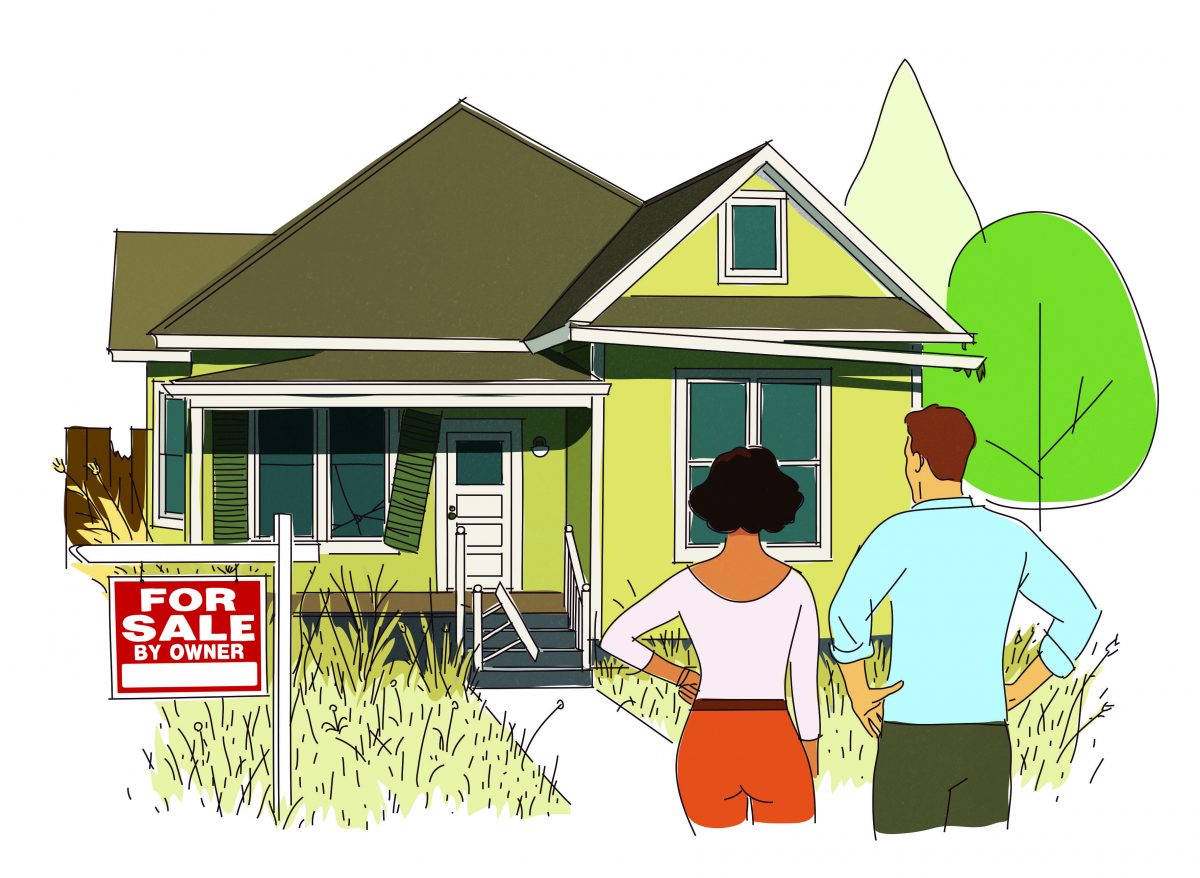
Here are Aaron’s 12 tips for buying a house:
- Check to see when the house sold last. This can point to a flip, which isn’t always bad, but flips tend to use lower-quality materials that might not stand up over time.
- You can get a decent idea if a wall is load-bearing or not by going into the basement or attic. If you have grand plans for an open-floor-plan remodel, this info could be critical.
- In the same vein, while you’re in the basement look for the main drain stack. Moving the main stack is rarely easy and often impossible.
- Look at the mechanicals. How old is the hot water tank, furnace, etc.? Are they direct vent or do they run through a chimney? Is it forced-air or hot-water heat? If it’s forced air, does it have AC? If it’s hot-water heat, it’ll take more effort to add AC later.
- Can you tell how old the roof is? See if this is disclosed on any of the paperwork.
- Do you see signs of previous damage or repairs? (interior and exterior)
- Can you look in the attic? Any obvious water damage? What about added insulation?
- Are the windows and doors original, and what’s the quality? Older vinyl windows or hollow-core doors might point to overall house quality.
- Do the windows function? (Are they painted shut, missing hardware, or do they slam closed when you try to leave them open?)
- This might be frowned upon, but I’m not shy about pulling up a corner of carpet to see if there are hardwoods. Try a closet first.
- Bulkheads (soffits) in kitchens may have duct work or other utility lines in them. Don’t always assume you can remove them to install taller upper cabinets.
- Bring a flashlight.
RELATED STORIES
Remember to send us your questions and suggestions to [email protected], and please like, comment, or review us no matter how you’re listening—it helps other folks find our podcast.
Happy Building!


























